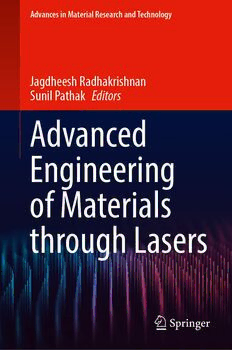Table Of ContentAdvances in Material Research and Technology
J. Radhakrishnan
Sunil Pathak Editors
Advanced
Engineering
of Materials
Through Lasers
Advances in Material Research and Technology
SeriesEditor
ShadiaJamilIkhmayies,PhysicsDepartment,IsraUniversity,Amman,Jordan
ThisSeriescoverstheadvancesanddevelopmentsinawiderangeofmaterialssuch
as energy materials, optoelectronic materials, minerals, composites, alloys and
compounds, polymers, green materials, semiconductors, polymers, glasses, nano-
materials, magnetic materials, superconducting materials, high temperature mate-
rials,environmentalmaterials,PiezoelectricMaterials,ceramics,andfibers.
Moreinformationaboutthisseriesathttps://link.springer.com/bookseries/16426
·
J. Radhakrishnan Sunil Pathak
Editors
Advanced Engineering
of Materials Through Lasers
Editors
J.Radhakrishnan SunilPathak
DepartamentodeFísicaAplicadae HiLaseCentre,InstituteofPhysics
IngenieríadeMateriales CzechAcademyofSciences
E.T.S.deIngenierosIndustriales DolniBrezany,CzechRepublic
UniversidadPolitécnicadeMadrid
Madrid,Spain
ISSN 2662-4761 ISSN 2662-477X (electronic)
AdvancesinMaterialResearchandTechnology
ISBN 978-3-031-03829-7 ISBN 978-3-031-03830-3 (eBook)
https://doi.org/10.1007/978-3-031-03830-3
©TheEditor(s)(ifapplicable)andTheAuthor(s),underexclusivelicensetoSpringerNature
SwitzerlandAG2022
Thisworkissubjecttocopyright.AllrightsaresolelyandexclusivelylicensedbythePublisher,whether
thewholeorpartofthematerialisconcerned,specificallytherightsoftranslation,reprinting,reuse
ofillustrations,recitation,broadcasting,reproductiononmicrofilmsorinanyotherphysicalway,and
transmissionorinformationstorageandretrieval,electronicadaptation,computersoftware,orbysimilar
ordissimilarmethodologynowknownorhereafterdeveloped.
Theuseofgeneraldescriptivenames,registerednames,trademarks,servicemarks,etc.inthispublication
doesnotimply,evenintheabsenceofaspecificstatement,thatsuchnamesareexemptfromtherelevant
protectivelawsandregulationsandthereforefreeforgeneraluse.
Thepublisher,theauthorsandtheeditorsaresafetoassumethattheadviceandinformationinthisbook
arebelievedtobetrueandaccurateatthedateofpublication.Neitherthepublishernortheauthorsor
theeditorsgiveawarranty,expressedorimplied,withrespecttothematerialcontainedhereinorforany
errorsoromissionsthatmayhavebeenmade.Thepublisherremainsneutralwithregardtojurisdictional
claimsinpublishedmapsandinstitutionalaffiliations.
ThisSpringerimprintispublishedbytheregisteredcompanySpringerNatureSwitzerlandAG
Theregisteredcompanyaddressis:Gewerbestrasse11,6330Cham,Switzerland
Preface
The4thindustrialrevolutionurgesallsectors,includingmanufacturingtodevelop
sustainable and advanced manufacturing processes with a solution to process the
partsaftermanufacturing.Thisrequiredintelligentmethodsandtechniquesinorder
to stay competitive in the global economy. Laser in recent times has been one of
themostsignificantcontributorsintheworldeconomy,alwayshelpingindustryby
latest development in promoting research and innovations to meet the accelerated
demand for productivity, quality, and sustainability. The development of lasers in
applicationsofadditivemanufacturing(AM)andpostprocessingofAMpartsand
compositestructureshasbeenachallengingworkinthecurrentandfuturescenario
of worlds manufacturing economy. The book will cover the process fundamentals
ofdifferentlaser-basedmanufacturingandprocessing,namely:lasershockpeening,
lasermicromachining,lasercutting,re-melting,andseveralotheraspectsrelatedto
thisfield.Laserinteractionwithdifferentmaterialsisaimtobepartofthebook.
This book will help in providing fundamental understanding and advanced
researchinsightsonlasermaterialsinteractionandtheirapplicationsinawiderange
ofconventionalandadvancedmanufacturing.
This book consists of eight chapters on fundamentals to advanced use of lasers
in manufacturing. Chapter “Introduction to Lasers and Processing’s of Materials”
presents a detailed overview of laser materials interaction. Chapter “Introduction
toGasandSolidStateLaserTechniquesinCuttingProcess”shedslightsonthegas
andsolidstatelasertechniquesincuttingprocess.Chapter“LaserCuttingofCeramic
MatrixComposites”presentsdetailsonlasercuttingofceramicmatrixcomposites.
Chapter “Laser Shock Peening: A Walkthrough” highlights the use of laser shock
peening(LSP)inadetailedmannertodiscusstheeffectsofLSPonmaterialsprop-
ertiesandfatiguelife.Chapter“LaserRe-MeltingofAtmosphericPlasmaSprayed
HighEntropyAlloy”describeslaserre-meltingofatmosphericplasmasprayedhigh
entropyalloy.Chapter“SurfaceMorphologyofNimonicAlloy263™inNanosecond
PulsedLaserAblation”presentsinsightsonsurfacemorphologyofNimonicAlloy
263™ in nanosecond pulsed laser ablation. Chapter “Laser-Based Post-processing
ofMetalAdditiveManufacturedComponents”shedshighlightsonlaser-basedpost-
processingofmetaladditivemanufacturedcomponents.ThebookendswithChapter
v
vi Preface
“AdvancesinSuperhydrophobicSurfaces:BiologytoBiomimetic”highlightingthe
advancesinsuperhydrophobicsurfaces:biologytobiomimetic.
I sincerely acknowledge Springer for this opportunity and their professional
support.Iamalsothankfultoallthechapter contributorsfortheiravailabilityand
valuablecontributions.
Madrid,Spain J.Radhakrishnan
DolniBrezany,CzechRepublic SunilPathak
Contents
IntroductiontoLasersandProcessing’sofMaterials .................. 1
AshishK.Shukla,AchyuthKulkarni,ShaliniSingh,S.Jayachandran,
AnshuSahu,andI.A.Palani
IntroductiontoGasandSolidStateLaserTechniquesinCutting
Process ........................................................... 33
S¸enolBayraktarandCemAlparslan
LaserCuttingofCeramicMatrixComposites ........................ 55
SundarMarimuthu,NiallBurtt,HelenElkington,andBethanSmith
LaserShockPeening:AWalkthrough ............................... 73
R.Sundar
LaserRe-MeltingofAtmosphericPlasmaSprayedHighEntropy
Alloy ............................................................. 105
HimanshuKumar, ChandraKumar, S.G.K.Manikandan,
M.Kamaraj,andS.Shiva
Surface Morphology of Nimonic Alloy 263™ in Nanosecond
PulsedLaserAblation ............................................. 129
ZhehaoJiang, SunilPathak, S.Subramani, J.Radhakrishnan,
andSundarMarimuthu
Laser-BasedPost-processingofMetalAdditiveManufactured
Components ...................................................... 147
A.N.Jinoop,S.Shiva,andC.P.Paul
AdvancesinSuperhydrophobicSurfaces:BiologytoBiomimetic ....... 171
S.SubramaniandJ.Radhakrishnan
Index ............................................................. 197
vii
Introduction to Lasers and Processing’s
of Materials
AshishK.Shukla,AchyuthKulkarni,ShaliniSingh,S.Jayachandran,
AnshuSahu,andI.A.Palani
1 Introduction
The materials processing from nano to micro and bulk level for various commer-
cial applications such as Texturing, engraving, and peening dedicated to commer-
cialapplicationscanbesubstantiatedemployingaLasersystem[1–4].Thematerial
processingemployinglasersystemischosendependingonthedemandofprocessing
capabilityanditsreal-lifeapplication[5,6].Theoutliningofalasersystemdepends
onlaserparameters,Laserwavelength,Pulseduration,LaserPower,andRepetition
rate [7, 8]. Besides, Identifying the absorption coefficient of range of laser wave-
length(225nmto1064nm)withsamplematerialbeforereal-timeinteractionwith
laser plays a significant role in outlining the experimental system and window for
experimentalparameters[9,10].
Figure1showstheapplicationoflasersinactuation,forming,peening,honing,
nitriding,patterning,andadditivemanufacturing[11].Inthefieldofactuation,alaser
canbeusedtoactuatesmartbi-morphmaterials[12].Thesmartbi-morphmaterial
is thin film of Ni–Ti-based smart material over the pre-strained flexible polyimide
substrate.Asmartbimorphisdifferentfromaconventionalbimorph[13].TheNi–
Tiisheat-sensitivematerial;therefore,itsbimorphcanbeactuatedwithadifferent
mediumofheatinputsuchaselectricalheating(Jouleheating)[14].
Theoutlinedwindowentirelydependsontheabsorptioncoefficientofmaterial
for the different wavelengths. The influence of varying laser wavelengths can be
B
A.K.Shukla( )
SchoolofDesignandInnovations,ATLASSKILLTECHUNIVERSITY,Mumbai400070,M.P.,
India
e-mail:[email protected]
A.Kulkarni·S.Singh·S.Jayachandran·A.Sahu·I.A.Palani
MechatronicsandInstrumentationLab,IndianInstituteofTechnologyIndore,Indore453552,
M.P,India
©TheAuthor(s),underexclusivelicensetoSpringerNatureSwitzerlandAG2022 1
J.RadhakrishnanandS.Pathak(eds.),AdvancedEngineeringofMaterialsThrough
Lasers,AdvancesinMaterialResearchandTechnology,
https://doi.org/10.1007/978-3-031-03830-3_1
2 A.K.Shuklaetal.
Fig.1 Laserprocessingofdifferentmaterialsandtheirapplicationinvariousfields
observedinthegraphrepresentedinFig.2[15].Theselectedmaterialiscomplex
in its lattice characteristics, such as polycrystalline polyimide flexible substrates
[16].Figure2Demonstratestheinfluenceoflaserwavelengthrangingfrom225to
1086nmoverflexiblepolymericsubstrates[16].Figure2Illustratestheabsorption
ofPIsubstrateisstartedreducingat450nmstraightupto550nm[17].Further,after
600nm,itshoulddecaystraight,whichisnothappeningduetothepolycrystalline
nature of the substrate [18]. In addition, the percentage increase in absorption for
PI substrate because of 355 nm laser processing compared to 1064 nm of laser
processingisconsideredasabsorptionof50%insimulationandsubsequently25%
Fig.2 Primary survey for the determination of transition band and highly absorbing region of
incidentlaserwavelength;UV–VisTransmissionspectroscopyofpristinepolyimide

